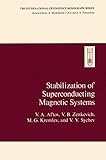Stabilization of superconducting magnetic systems [Libro electrónico] / V. A. Al'tov, V. B. Zenkevich, M. G. Kremlev, V. V. Sychev
Por: Al'tov, V. A [autor/a].
Zenkevich, V. B [autor/a] | Kremlev, M. G [autor/a] | Sychev, V. V [autor/a].
Tipo de material: Libro
en línea Series Editor: New York, New York, United States: Plenum Press, c1977Descripción: xiv, 338 páginas : ilustraciones ; 24 centímetros.ISBN: 0306309432; 9781461341178 (Print); 9781461341154 (Online).Tema(s): Superconducting magnetsNota de acceso: Disponible para usuarios de ECOSUR con su clave de acceso Nota de bibliografía: Incluye bibliografía e índice: páginas 333-336 Número de sistema: 55227Contenidos:Mostrar
Resumen:
Libro
en línea Series Editor: New York, New York, United States: Plenum Press, c1977Descripción: xiv, 338 páginas : ilustraciones ; 24 centímetros.ISBN: 0306309432; 9781461341178 (Print); 9781461341154 (Online).Tema(s): Superconducting magnetsNota de acceso: Disponible para usuarios de ECOSUR con su clave de acceso Nota de bibliografía: Incluye bibliografía e índice: páginas 333-336 Número de sistema: 55227Contenidos:Mostrar
Resumen:| Tipo de ítem | Biblioteca actual | Colección | Signatura | Estado | Fecha de vencimiento | Código de barras |
|---|---|---|---|---|---|---|
| Libros | Biblioteca Electrónica Recursos en línea (RE) | Acervo General | Recurso digital | ECO400552275893 |
Incluye bibliografía e índice: páginas 333-336
• Superconductivity and its applications.. The future of superconductivity in modern technology.. The nature of superconductivity.. Protection of superconducting magnetic systems.. • Method of thermal stabilization.. Equilibrium of the normal zone in combined conductors under isothermal conditions.. Equilibrium of the normal zone in combined conductors in the presence of a longitudinal temperature gradient.. Propagation of the normal zone in a superconducting coil.. Combined conductors with forced cooling.. Equilibrium and propagation of the normal zone in a close-packed superconducting coil.. • Combined conductors with internal stabilization.. Stability of superconductors of the second kind with respect to flux jumps.. Multiple-core straight conductors.. Twisted and coiled combined conductors.. Index
Disponible para usuarios de ECOSUR con su clave de acceso
I am indeed pleased to prepare this brief foreword for this book, written by several of my friends and colleagues in the Soviet Union. The book was first published in the Russian language in Moscow in 1975. The phenomenon of superconductivity was discovered in 1911 and promised to be important to the production of electromagnets since superconductors would not dissipate Joule heat. Unfortunate ly the first materials which were discovered to be superconducting reverted to the normal resistive state in magnetic fields of a few tesla. Thus the development that was hoped for by hundredths of a the early pioneers was destined to be delayed for over half a century. In 1961 the intermetallic compound NbaSn was found to be superconducting in a field of about 200 teslas. This breakthrough marked a turning point, and 50 years after the discovery of superconductivity an intensive period of technological development began. There are many applications of superconductivity that are now being pursued, but perhaps one of the most important is super conducting magnetic systems. There was a general feeling in the early 1960s that the intermetallic compounds and alloys that were found to retain superconductivity in the presence of high magnetic fields would make the commercialization of superconducting magnets a relatively simple matter. However, the next few years were ones of disillusionment; large magnets were found to be unstable, causing them to revert to the normal state at much lower magnetic fields than predicted. eng
Disponible en línea
Disponible en formato PDF
Subscripción a ELSEVIER 26 de diciembre del 2013
